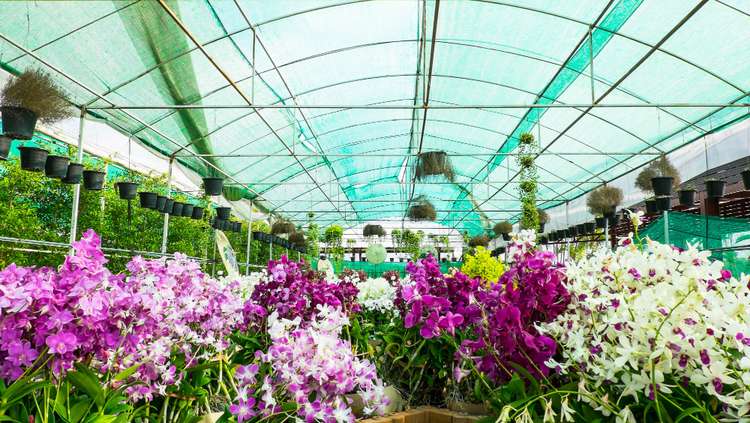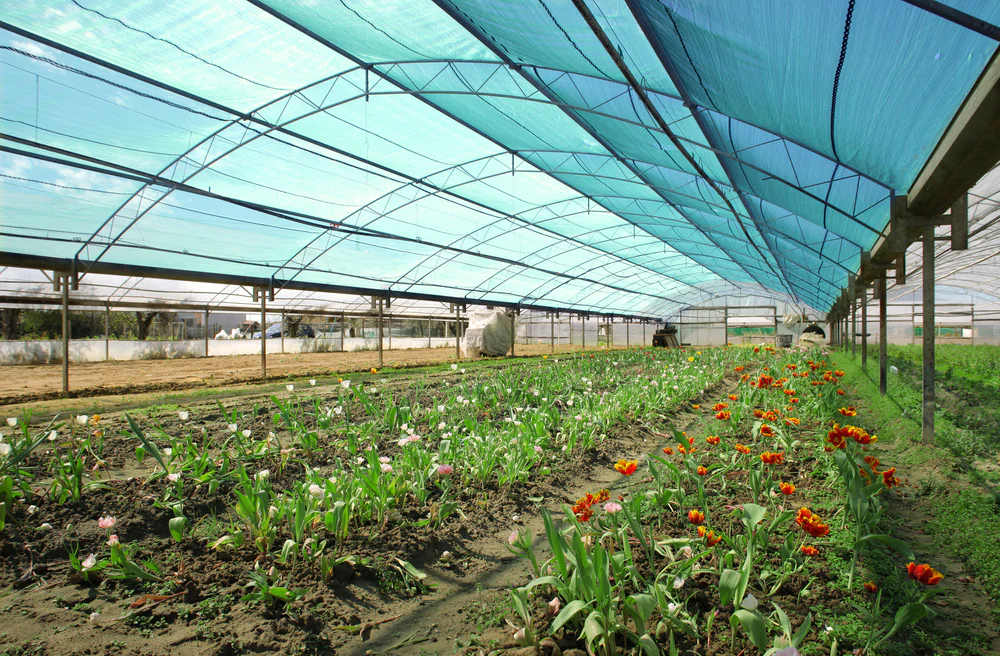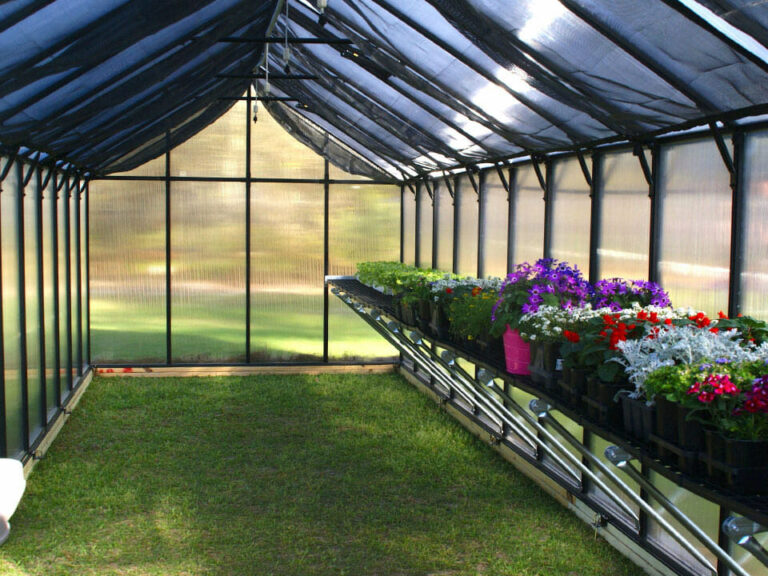I had a thought that day that changed how I garden forever: What’s the best color cloth for shade in a greenhouse? I didn’t realize then that finding the answer would be so interesting and teach me all about how to give my plants just the right amount of light.
The choice of shade cloth color for a greenhouse depends on factors like light transmission, climate, plant requirements, durability, aesthetics, and budget. Dark-colored shade cloths provide high shade levels (80-90%) and are ideal for plants that need significant shading. Green shade cloths (40-60% shade) are suitable for general use.
On the other hand, white shade cloths in a greenhouse offer benefits like reflecting sunlight, diffusing light evenly, and reducing heat buildup. They are suitable for a wide range of plants and provide moderate shading (around 50%). White shade cloths are ideal for hot climates and heat-sensitive plants.
Consider your location, the plants you’re growing, and your budget when selecting the shade cloth color. Multiple colors or shading percentages can be used in the same greenhouse to meet different plant needs.
What Are the Key Factors to Consider When Choosing Shade Cloth?

When selecting shade cloth for your greenhouse, several key factors should guide your decision-making process, ensuring optimal conditions for your plants and efficient energy management.
Light Transmission
When it comes to cultivating a diverse range of plants, understanding their distinct light requirements is crucial. Each plant species has its own preference when it comes to light exposure. Some thrive in direct sunlight, basking in its full glory, while others are more delicate, preferring the gentle embrace of partial or filtered sunlight.
To cater to these varying needs, shade cloth becomes an invaluable tool. Shade cloth is available in different shading percentages, such as 30%, 50%, or 70%, which directly impact the amount of sunlight that filters through to your plants.
Therefore, when selecting shade cloth for your greenhouse, it is essential to consider the specific light intensity needs of the plants you are nurturing. Prioritize research on the ideal light conditions for your plant varieties and opt for a shade cloth with a shading percentage that aligns with those requirements.
This thoughtful approach to light management ensures the optimal growth and health of your greenhouse plants.
Heat Retention
Effectively managing the temperature within a greenhouse is a fundamental aspect of successful plant cultivation. Shade cloth, while primarily known for its light-diffusing properties, plays a pivotal role in temperature regulation as well.
Particularly during scorching summer months, shade cloth becomes an indispensable ally by mitigating overheating. By reducing the influx of direct sunlight and its accompanying heat, it creates a cooler and more stable environment, providing a haven for temperature-sensitive plants.
Conversely, as colder seasons approach, your greenhouse strategy may necessitate adjustments to the shade cloth. Depending on your specific climate and the temperature requirements of your plants, you might opt to either modify the shade cloth or even remove it altogether to allow more sunlight and warmth to penetrate.
Furthermore, this adaptability in managing the greenhouse environment is crucial to ensure the optimal health and growth of your plants. In essence, the judicious use of shade cloth is an integral part of maintaining the ideal temperature balance within your greenhouse year-round.
UV Protection
Shielding plants from the potentially harmful effects of ultraviolet (UV) radiation is a paramount concern for greenhouse growers. UV rays can inflict sunburn and various forms of damage on plants, jeopardizing their health and vitality.
Here, shade cloth emerges as a formidable defense against these detrimental UV rays, effectively acting as a protective barrier. By utilizing shade cloth, the risk of sun-related plant stress is significantly diminished.
Furthermore, this UV protection is of particular importance for greenhouse-cultivated plants, which often receive more intense and direct sunlight than their outdoor counterparts. To ensure lasting protection for your cherished flora, it is advisable to select shade cloth crafted from UV-stabilized materials.
However, it’s worth noting that the choice of shade cloth color can also influence the degree of UV protection it provides. Hence, a judicious selection, taking into account both the material and color of the shade cloth, is essential in safeguarding your plants from the harmful effects of UV radiation.
Durability
longevity and maintenance are pivotal considerations to maximize its utility over multiple growing seasons. First and foremost, the choice of material is paramount. Opt for high-quality materials like woven polyethylene or knitted fabric, as they tend to exhibit greater durability. These materials are more resistant to common issues such as tearing, fraying, and UV degradation, ensuring that your shade cloth remains effective and intact.
Additionally, adopting a proactive approach to maintenance is key to prolonging the life of your shade cloth. Regular cleaning and proper storage during the off-season can significantly extend its longevity, preventing the buildup of dirt, debris, and potential damage.
Moreover, it’s advisable to explore warranties or guarantees offered by the manufacturer. These assurances can provide valuable insights into the durability and expected lifespan of the product, aiding in your decision-making process.
Cost and Budget
It’s important to acknowledge that costs can fluctuate widely, contingent on various factors like material quality, shading percentage, and dimensions. To make an informed decision, it’s imperative to undertake a comprehensive assessment.
Begin by evaluating your budget and accurately determining the size of your greenhouse. While opting for the most affordable shade cloth may seem tempting initially, it’s wise to consider the long-term advantages of investing in a higher-quality, more durable option. Quality shade cloth not only provides better protection for your plants but can also lead to potential energy savings. Reduced cooling costs during hot weather and improved plant productivity can offset the initial expenditure.
Furthermore, to make a well-informed choice, take the time to compare prices from different suppliers. Weigh the overall value of the shade cloth against its cost, considering factors like material durability and shading efficiency.
In essence, a thorough evaluation of your budget, greenhouse size, and long-term benefits is pivotal in selecting the most suitable shade cloth that aligns with your needs and priorities.
What Are the Available Color Options for Shade Cloth?

Shade cloth comes in a variety of colors, each with its unique benefits and effects on plants.
White Shade Cloth
Benefits:
- High Light Reflectivity: White shade cloth reflects a significant amount of sunlight, helping to maintain a cooler temperature inside the greenhouse. This is especially beneficial in hot climates.
- Uniform Light Distribution: White shade cloth diffuses light evenly, reducing hotspots and shadows within the greenhouse.
- Reduced Heat Stress: It helps prevent overheating, making it suitable for shade-loving plants.
- UV Reflection: White shade cloth provides good UV protection for plants.
Drawbacks:
- Limited Shading: White shade cloth may not provide as much shading as darker colors, which can be a drawback if your plants require significant shade.
- Algae Growth: Over time, white shade cloth may develop algae growth due to its high light reflectivity. Regular cleaning may be necessary to address this issue.
Black Shade Cloth
Benefits:
- Maximum Shading: Black shade cloth offers the highest shading percentage, making it suitable for light-sensitive plants.
- Improved Heat Retention: It helps retain heat during cooler months and nights, providing a more stable environment for plants.
- Low Maintenance: Black shade cloth is less prone to staining and algae growth compared to lighter colors.
Drawbacks:
- Limited Light Reflectivity: Black shade cloth absorbs more heat and may contribute to higher temperatures within the greenhouse, which can be a drawback in hot climates.
- Reduced UV Protection: It may offer less UV protection compared to lighter colors, potentially exposing plants to harmful UV rays.
Green Shade Cloth
Benefits:
- Balanced Shading: Green shade cloth provides a balanced compromise between shading and light transmission, making it versatile for a wide range of plants.
- Aesthetically Pleasing: The green color blends well with the natural environment and is often preferred for its aesthetic appeal.
- Moderate Heat Control: It helps in temperature regulation without excessive heat retention.
Drawbacks:
- Moderate UV Protection: Green shade cloth offers moderate UV protection, which may be insufficient for highly UV-sensitive plants.
- Less Heat Retention: It may not retain heat as effectively as black shade cloth during colder periods.
Aluminet Shade Cloth
Benefits:
- High Reflectivity: Aluminet shade cloth features a reflective aluminum coating, which offers excellent sunlight reflection, making it suitable for hot climates.
- Improved Temperature Control: It effectively reduces heat buildup inside the greenhouse.
- UV Protection: Aluminet provides good UV protection for plants while maintaining a cool environment.
- Durability: It is often durable and resistant to UV degradation.
Drawbacks:
- Cost: Aluminet shade cloth can be more expensive than other options, but its energy-saving benefits may offset the initial investment.
- Special Cleaning Requirements: Cleaning aluminet shade cloth requires more care to avoid damaging the reflective coating.
Custom Colors and Blends
Some manufacturers offer custom colors and blends of shade cloth, allowing you to tailor the shading properties to your specific plant and climate needs. Furthermore, custom options can provide a unique balance of shading and light transmission, making them ideal for specialized greenhouse setups.
However, when considering custom options, consult with the manufacturer or supplier to ensure the cloth meets your requirements.
FAQ’s :
What is the best percentage shade cloth for a greenhouse?
The best percentage shade cloth for a greenhouse depends on the specific light requirements of the plants you’re growing. It varies between 30% to 70%, with choices in between.
What color shade cloth is best for vegetables?
Green shade cloth is often a good choice for vegetables, as it provides a balanced shading effect that suits a wide range of vegetable plants.
Is black or green shade cloth better?
The choice between black and green shade cloth depends on your specific needs. Black offers more shading, while green provides a balance between shading and light transmission.
Is 40% shade cloth good for plants?
Yes, 40% shade cloth can be suitable for many plants, especially those that require partial shade. However, the choice depends on the particular light needs of your plants and your climate.
Will plants grow under 70% shade cloth?
Yes, plants can grow under 70% shade cloth, but it’s best suited for shade-loving plants or in areas with intense sunlight. It provides significant shading.
Does rain penetrate shade cloth?
Yes, most shade cloth allows rain to penetrate to some extent, but it can also provide some protection from heavy rainfall, preventing damage to delicate plants.
Final Thought :
In conclusion, my journey through the intricate world of greenhouse shade cloth has been enlightening. As I’ve delved into the factors crucial for selecting the right shade cloth, such as light transmission, heat retention, UV protection, durability, and budget considerations,
Moreover, I’ve come to appreciate the nuanced choices available to greenhouse enthusiasts. The exploration of various color options, from the cooling embrace of white and the light moderation of green to the sun-absorbing properties of black and the reflective charm of aluminet, has unveiled a spectrum of possibilities to suit diverse plant needs and regional climates.
Additionally, the potential for custom blends opens doors to tailor-made solutions for specific greenhouse setups. Armed with this knowledge, I feel empowered to make an informed decision that will not only enhance plant health and growth but also contribute to the overall success of my greenhouse endeavors.
So, as I embark on this journey, I do so with confidence, knowing that the right shade cloth will be a crucial partner in nurturing my botanical haven.

